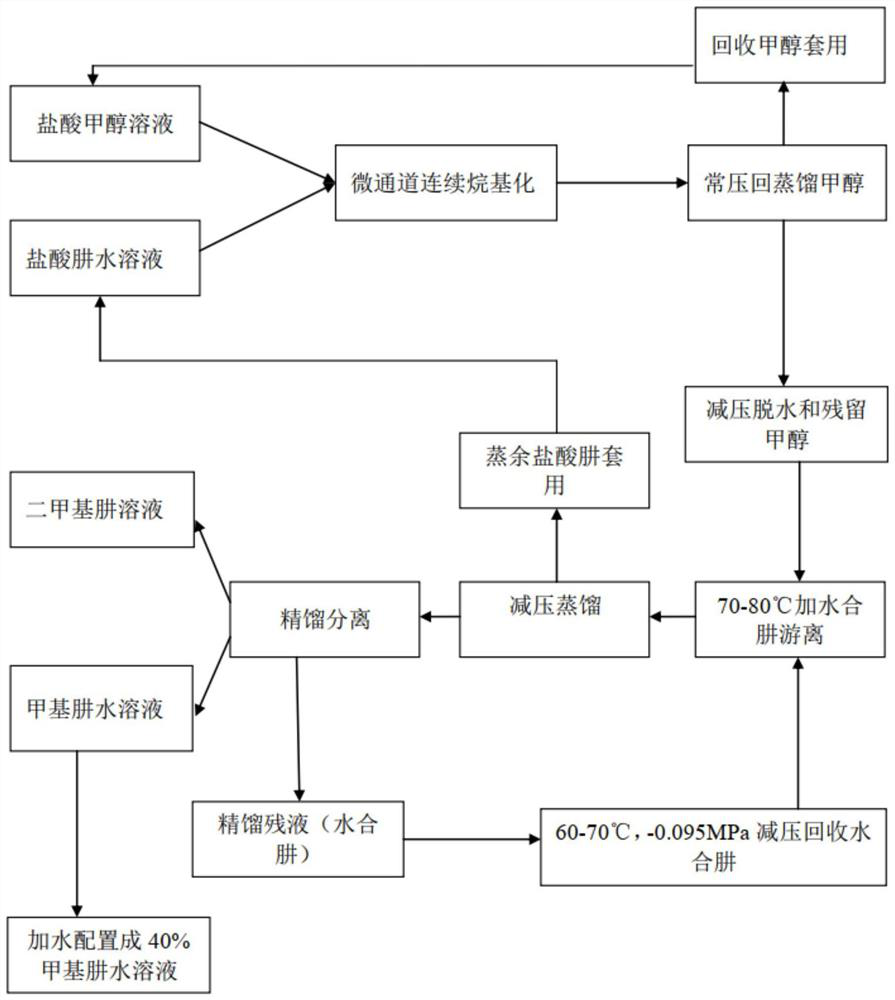Methylhydrazine continuous flow microchannel alkylation method
A technology of methylhydrazine and alkylation, which is applied in the field of methylhydrazine preparation, can solve the problems of small scale, difficulty in adapting to the violent reaction environment of methylhydrazine, and difficulty in large-scale industrial production, so as to reduce the generation of by-products and ensure safety High performance, reduce the effect of side effects
- Summary
- Abstract
- Description
- Claims
- Application Information
AI Technical Summary
Problems solved by technology
Method used
Image
Examples
Embodiment 1
[0050] (1) Hydrazine hydrochloride is mixed with water to prepare an aqueous solution of hydrazine hydrochloride so that the mass percentage concentration of hydrazine hydrochloride is 75%, and methyl alcohol is mixed with a concentration of 30% aqueous hydrochloric acid to prepare methanolic hydrochloride solution so that the concentration of hydrochloric acid is 3%. ;
[0051] (2) send the hydrochloric acid methanol solution into the microchannel of the microchannel reactor with a pump earlier, fill up the microchannel, then use the pump to send the hydrazine hydrochloride aqueous solution into the microchannel, so that the hydrazine hydrochloride and methyl alcohol are continuously reacted in the microchannel, Wherein, the reaction temperature is 110°C, the reaction pressure is 0.4MPa, the residence time is 15min, the mass ratio of hydrazine hydrochloride and methanol is controlled to be 1:1.05, and the aqueous solution of hydrazine hydrochloride is controlled to be sent int...
Embodiment 2
[0058] (1) Hydrazine hydrochloride is mixed with water to prepare an aqueous solution of hydrazine hydrochloride so that the mass percentage concentration of hydrazine hydrochloride is 85%, and methyl alcohol is mixed with a concentration of 30% aqueous hydrochloric acid to prepare methanolic hydrochloride solution so that the concentration of hydrochloric acid is 3%. ;
[0059] (2) send the hydrochloric acid methanol solution into the microchannel of the microchannel reactor with a pump earlier, fill up the microchannel, then use the pump to send the hydrazine hydrochloride aqueous solution into the microchannel, so that the hydrazine hydrochloride and methyl alcohol are continuously reacted in the microchannel, Wherein, the reaction temperature is 120°C, the reaction pressure is 0.3MPa, the residence time is 10min, the mass ratio of hydrazine hydrochloride and methanol is controlled to be 1:1.15, and the aqueous solution of hydrazine hydrochloride is sent into the microchanne...
Embodiment 3
[0066] (1) Hydrazine hydrochloride is mixed with water to prepare an aqueous solution of hydrazine hydrochloride so that the mass percent concentration of hydrazine hydrochloride is 80%, and methyl alcohol is mixed with a concentration of 30% aqueous hydrochloric acid to prepare a methanolic hydrochloride solution so that the concentration of hydrochloric acid is 3%. ;
[0067] (2) send the hydrochloric acid methanol solution into the microchannel of the microchannel reactor with a pump earlier, fill up the microchannel, then use the pump to send the hydrazine hydrochloride aqueous solution into the microchannel, so that the hydrazine hydrochloride and methyl alcohol are continuously reacted in the microchannel, Wherein, the reaction temperature is 115°C, the reaction pressure is 0.35MPa, and the residence time is 12.5min. The mass ratio of hydrazine hydrochloride and methanol is controlled to be 1:1.1, and the aqueous solution of hydrazine hydrochloride is controlled to be sen...
PUM
 Login to View More
Login to View More Abstract
Description
Claims
Application Information
 Login to View More
Login to View More - R&D
- Intellectual Property
- Life Sciences
- Materials
- Tech Scout
- Unparalleled Data Quality
- Higher Quality Content
- 60% Fewer Hallucinations
Browse by: Latest US Patents, China's latest patents, Technical Efficacy Thesaurus, Application Domain, Technology Topic, Popular Technical Reports.
© 2025 PatSnap. All rights reserved.Legal|Privacy policy|Modern Slavery Act Transparency Statement|Sitemap|About US| Contact US: help@patsnap.com



